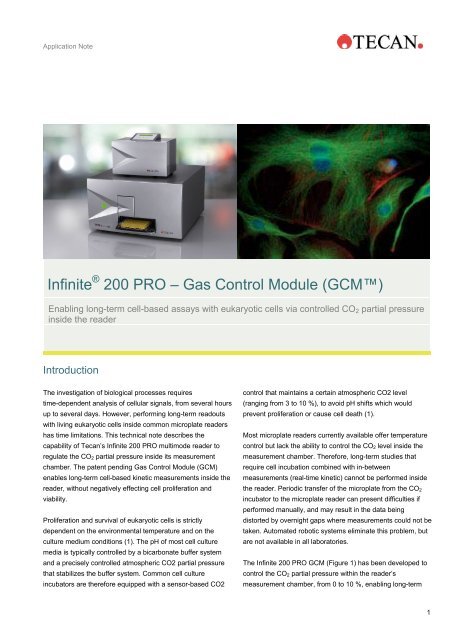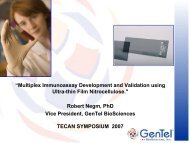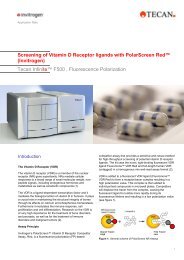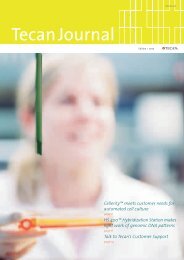Infinite 200 PRO – Gas Control Module (GCM™) - Tecan
Infinite 200 PRO – Gas Control Module (GCM™) - Tecan
Infinite 200 PRO – Gas Control Module (GCM™) - Tecan
You also want an ePaper? Increase the reach of your titles
YUMPU automatically turns print PDFs into web optimized ePapers that Google loves.
Application Note<br />
<strong>Infinite</strong> ® <strong>200</strong> <strong>PRO</strong> <strong>–</strong> <strong>Gas</strong> <strong>Control</strong> <strong>Module</strong> (GCM)<br />
Enabling long-term cell-based assays with eukaryotic cells via controlled CO2 partial pressure<br />
inside the reader<br />
Introduction<br />
The investigation of biological processes requires<br />
time-dependent analysis of cellular signals, from several hours<br />
up to several days. However, performing long-term readouts<br />
with living eukaryotic cells inside common microplate readers<br />
has time limitations. This technical note describes the<br />
capability of <strong>Tecan</strong>’s <strong>Infinite</strong> <strong>200</strong> <strong>PRO</strong> multimode reader to<br />
regulate the CO2 partial pressure inside its measurement<br />
chamber. The patent pending <strong>Gas</strong> <strong>Control</strong> <strong>Module</strong> (GCM)<br />
enables long-term cell-based kinetic measurements inside the<br />
reader, without negatively effecting cell proliferation and<br />
viability.<br />
Proliferation and survival of eukaryotic cells is strictly<br />
dependent on the environmental temperature and on the<br />
culture medium conditions (1). The pH of most cell culture<br />
media is typically controlled by a bicarbonate buffer system<br />
and a precisely controlled atmospheric CO2 partial pressure<br />
that stabilizes the buffer system. Common cell culture<br />
incubators are therefore equipped with a sensor-based CO2<br />
control that maintains a certain atmospheric CO2 level<br />
(ranging from 3 to 10 %), to avoid pH shifts which would<br />
prevent proliferation or cause cell death (1).<br />
Most microplate readers currently available offer temperature<br />
control but lack the ability to control the CO2 level inside the<br />
measurement chamber. Therefore, long-term studies that<br />
require cell incubation combined with in-between<br />
measurements (real-time kinetic) cannot be performed inside<br />
the reader. Periodic transfer of the microplate from the CO2<br />
incubator to the microplate reader can present difficulties if<br />
performed manually, and may result in the data being<br />
distorted by overnight gaps where measurements could not be<br />
taken. Automated robotic systems eliminate this problem, but<br />
are not available in all laboratories.<br />
The <strong>Infinite</strong> <strong>200</strong> <strong>PRO</strong> GCM (Figure 1) has been developed to<br />
control the CO2 partial pressure within the reader’s<br />
measurement chamber, from 0 to 10 %, enabling long-term<br />
1
Application Note<br />
studies with eukaryotic cells using alternating incubation and<br />
measurement steps. Cellular survival and proliferation is<br />
therefore no longer limited to common CO2 incubators, and<br />
long-term cell-based analysis, such as cell proliferation<br />
studies, can be performed inside the reader, offering<br />
reproducible measurements without gaps in the data.<br />
Figure 1 <strong>Tecan</strong>’s patent pending <strong>Gas</strong> <strong>Control</strong> <strong>Module</strong> (GCM),<br />
compatible with the <strong>Infinite</strong> <strong>200</strong> <strong>PRO</strong> series.<br />
Materials and methods<br />
Instrument<br />
● <strong>Infinite</strong> M<strong>200</strong> <strong>PRO</strong> Quad4 Monochromators-based<br />
multimode reader, including <strong>Gas</strong> <strong>Control</strong> <strong>Module</strong> (GCM)<br />
equipped with CO2 supply<br />
Microplates<br />
● 96-well, Lumox, black with transparent bottom, tissue<br />
culture treated (Sarstedt, Germany)<br />
Reagents<br />
● Human squamous epidermoid carcinoma cells (A431,<br />
ATCC # CLR-1555)<br />
● Dulbecco's Modified Eagle Medium high glucose<br />
(DMEM), heat-inactivated fetal calf serum (FCS, PAA<br />
Laboratories)<br />
● Enhanced green fluorescent protein (EGFP)<br />
● L-glutamine (PAA Laboratories)<br />
● sodium pyruvate (PAA Laboratories)<br />
● penicillin / streptomycin (PAA Laboratories)<br />
● HEPES (PAA Laboratories)<br />
● Trypsin (PAA Laboratories)<br />
● EDTA (PAA Laboratories)<br />
Cell culture and test set-up<br />
Human squamous epidermoid carcinoma cells (A431), stably<br />
transfected with EGFP, were grown to confluence in DMEM<br />
high glucose supplemented with L-glutamine, sodium<br />
pyruvate, penicillin / streptomycin, HEPES and 5 %<br />
heat-inactivated fetal calf serum (FCS) at 37 °C and 5 % CO2<br />
in a humidified atmosphere (standard CO2 incubator with<br />
passive humidity control, Forma Steri-Cycle 371, Thermo).<br />
The cells were harvested using trypsin / EDTA, then<br />
resuspended in fresh growth medium containing 5 % FCS,<br />
seeded into black Lumox, 96-well tissue culture plates<br />
(5000 cells / well in <strong>200</strong> µl filling volume) and covered with a<br />
standard microplate lid (Figure 2).<br />
Figure 2 Plate layout; 5000 cells were seeded with and without FCS.<br />
After overnight incubation (~14 hrs) in a standard CO2<br />
incubator, the culture medium was replaced (rows A-D were<br />
filled with fresh DMEM containing 5 % FCS, rows E-H were<br />
filled with fresh DMEM without FCS) and all plates were<br />
sealed by covering the interspace between plate and lid with<br />
Parafilm ® (Brand GmbH, Germany) to avoid evaporation<br />
during the long-term growth study. Alternatively, plates can be<br />
sealed using a real-time PCR film (e.g. ThermalSeal<br />
RT2RR, Excel Scientific, USA). CO2 supply was still<br />
possible, as Lumox plates enable gas transfer through their<br />
fluorocarbon film base (2).<br />
The influence of the GCM-based CO2 regulation on cell<br />
proliferation was determined using three different<br />
experimental setups:<br />
2
Application Note<br />
I. GCM plate<br />
Handling<br />
Plate left in the <strong>Infinite</strong> M<strong>200</strong> <strong>PRO</strong> reader<br />
with active CO2 control for incubation and<br />
measurement<br />
Duration of analysis 75 hrs<br />
CO2 control (reader) 5 % (GCM controlled)<br />
Temperature (reader) 37 °C<br />
Kinetic (plate wise) 76 cycles (1 hr intervals)<br />
Measurement mode<br />
Enhanced fluorescence intensity bottom,<br />
optimal read, 28 flashes (4 x 7)<br />
Excitation wavelength 485 (9) nm<br />
Emission wavelength 535 (20) nm<br />
Pre-optimized for max. cell number / well<br />
Gain<br />
(5 x 10 4 cells) and then set manually<br />
Table 1 Handling and measurement parameters for microplate incubation<br />
and measurement in the <strong>Infinite</strong> M<strong>200</strong> <strong>PRO</strong> with GCM.<br />
II. Positive control plate<br />
Handling<br />
Plate incubated in a standard CO2<br />
incubator and manually transferred to<br />
the <strong>Infinite</strong> M<strong>200</strong> <strong>PRO</strong> reader for<br />
measurement only<br />
Duration of analysis 75 hrs<br />
CO2 control (incubator) 5 %<br />
Temperature (incubator) 37 °C<br />
Measurement interval Hourly (when possible)<br />
Measurement mode<br />
Enhanced fluorescence intensity bottom,<br />
optimal read, 28 flashes (4 x 7)<br />
Excitation wavelength 485 (9) nm<br />
Emission wavelength 535 (20) nm<br />
Pre-optimized for max. cell number / well<br />
Gain<br />
(5 x 10 4 cells) and then set manually<br />
Table 2 Handling and measurement parameters for microplate incubation<br />
in a standard CO2 incubator and measurement in the <strong>Infinite</strong> M<strong>200</strong> <strong>PRO</strong>.<br />
III. Negative control plate<br />
Handling<br />
Plate left in the <strong>Infinite</strong> M<strong>200</strong> <strong>PRO</strong><br />
reader without CO2 control for incubation<br />
and measurement (75 hrs)<br />
Duration of analysis 75 hrs<br />
CO2 control (reader) N.A.<br />
Temperature (reader) 37 °C<br />
Kinetic (plate wise) 76 cycles (1 hr intervals)<br />
Measurement mode<br />
Enhanced fluorescence intensity bottom,<br />
optimal read, 28 flashes (4 x 7)<br />
Excitation wavelength 485 (9) nm<br />
Emission wavelength 535 (20) nm<br />
Pre-optimized for max. cell number / well<br />
Gain<br />
(5 x 10 4 cells) and then set manually<br />
Table 3 Handling and measurement parameters for microplate incubation<br />
and measurement in the <strong>Infinite</strong> M<strong>200</strong> <strong>PRO</strong> without GCM.<br />
All plates were measured with 0 µs lag time and 20 µs<br />
integration time using the GRE96fb.pdfx plate definition file,<br />
and all recorded fluorescence signal intensities were<br />
calculated relative to the initial fluorescent signal (initial cell<br />
number at t = 0 hrs, representing 100 % GFP signal).<br />
Results and discussion<br />
Figure 3 shows growth curves of cells seeded at an initial<br />
concentration of 5000 cells / well in DMEM containing 5 %<br />
FCS (A) and DMEM without FCS (B), respectively.<br />
Cells incubated with 5 % FCS<br />
Figure 3A shows growth curves of cells cultured in DMEM with<br />
5 % FCS. Cells incubated and measured in an<br />
<strong>Infinite</strong> M<strong>200</strong> <strong>PRO</strong> with CO2 control (green circle) show<br />
significant proliferation up to 75 hrs (700 %, ~ 3.5 x 10 4 cells).<br />
This is comparable to the growth of the positive control (red<br />
triangle), with 900 % proliferation (~ 4.5 x 10 4 ). Growth curves<br />
from the positive control experiment lack data points due to<br />
overnight breaks, whereas growth curves from the long-term<br />
kinetic measurement performed in the <strong>Infinite</strong> M<strong>200</strong> <strong>PRO</strong> with<br />
GCM do not have this critical limitation.<br />
Cells incubated and measured in a microplate reader without<br />
CO2 control (blue square) show limited proliferation up to 18<br />
hrs (140 %, ~7 x 10 3 cells). After this period, cells stop<br />
proliferating and the signal actually decreases down to 75 %<br />
(~ 3.75 x 10 3 cells).<br />
Cells incubated without FCS<br />
Figure 3B shows growth curves of cells cultured in DMEM<br />
without FCS. This is relevant for many applications where<br />
FCS in the medium is disadvantageous. For example, FCS is<br />
regularly omitted when incubating cells with a compound that<br />
may induce cytotoxicity, as it non-specifically binds to the<br />
compound, partly inhibiting its uptake by cells.<br />
As expected, cells grown in medium without FCS show<br />
significantly lower overall proliferation rates compared to cells<br />
grown in medium containing 5 % FCS. Cell proliferation of the<br />
positive control (330 %, 1.65 x 10 4 cells) was comparable to<br />
proliferation of cells incubated and measured in the<br />
<strong>Infinite</strong> <strong>200</strong> <strong>PRO</strong> with GCM (260 %, 1.3 x 10 4 ). Again, cells<br />
incubated and measured in a reader without GCM show non-<br />
3
Application Note<br />
significant proliferation up to 18 hrs (135 %, ~ 6.75 x 10 3 cells)<br />
which then declines to 75 % (3.75 x 10 3 cells).<br />
Figure 3 Proliferation of cells cultured with (A) and without FCS (B) and<br />
monitored for 75 hrs.<br />
To investigate possible evaporation during long-term<br />
incubation, the remaining filling volume was determined. For<br />
the plate incubated in the standard CO2 incubator, which was<br />
equipped with passive humidity control, an average volume of<br />
190 µl (i.e. 95 %) remained per microplate well. For the plates<br />
incubated in <strong>Infinite</strong> M<strong>200</strong> <strong>PRO</strong> readers (with and without<br />
GCM) an average volume of 180 µl (i.e. 90 %) remained after<br />
a period of 75 hrs. Similar growth is seen in the reader with<br />
GCM compared to the data of the standard cell incubator if<br />
sealed plates with gas permeable bottoms are used,<br />
demonstrating that humidity control is not mandatory inside<br />
the microplate reader.<br />
Conclusion<br />
Results presented in this technical note clearly demonstrate<br />
that the <strong>Infinite</strong> <strong>200</strong> <strong>PRO</strong> multimode reader, combined with<br />
<strong>Tecan</strong>’s new <strong>Gas</strong> <strong>Control</strong> <strong>Module</strong>, offers the capability to<br />
perform long-term cell-based studies lasting several days.<br />
Over the whole 75 hr period, cells left in a reader with GCM<br />
proliferate comparably to cells left in a common CO2<br />
incubator, whereas cells left in a reader without CO2 control<br />
stop proliferation after several hours. Growth curves resulting<br />
from experiments performed in an <strong>Infinite</strong> M<strong>200</strong> <strong>PRO</strong> with<br />
GCM do not lack any data points (no overnight gaps), which is<br />
a significant benefit for many long-term experiments.<br />
<strong>Tecan</strong>’s new patent pending <strong>Gas</strong> <strong>Control</strong> <strong>Module</strong> is an<br />
innovative solution for cell-based experiments, offering<br />
rigorous environmental control within the detection chamber.<br />
By offering precise regulation of carbon dioxide levels within<br />
the reader, the GCM provides a more stable culture<br />
environment over time, making it ideally suited for real-time<br />
analysis of biological processes. This integrated gas inlet with<br />
external control of CO2 stabilizes the pH value of the culture<br />
medium, helping to improve cell growth.<br />
4
Application Note<br />
Literature<br />
(1) Martin Clynes, Animal Cell Culture Techniques, Springer<br />
Lab Manual, 618 pages, ISBN-10: 3540630082, 1998<br />
(2) www.sarstedt.com<br />
List of Abbreviations<br />
A431 Human squamous epithelial carcinoma cells<br />
DMEM Dulbecco's Modified Eagle Medium<br />
EDTA Ethylenediaminetetraacetic acid<br />
FCS Fetal calf serum<br />
GCM <strong>Gas</strong> <strong>Control</strong> <strong>Module</strong><br />
HEPES 2-(4-(2-Hydroxyethyl)-1-piperazinyl)ethanesulfonic<br />
acid<br />
Austria +43 62 46 89 33 Belgium +32 15 42 13 19 China +86 21 2898 6333 Denmark +45 70 23 44 50 France +33 4 72 76 04 80 Germany +49 79 51 94 170<br />
Italy +39 02 92 44 790 Japan +81 44 556 73 11 Netherlands +31 18 34 48 174 Portugal +351 21 000 82 16 Singapore +65 644 41 886 Spain +34 93 490 01 74<br />
Sweden +46 31 75 44 000 Switzerland +41 44 922 89 22 UK +44 118 9300 300 USA +1 919 361 5<strong>200</strong> Other countries +41 44 922 8125<br />
<strong>Tecan</strong> Group Ltd. makes every effort to include accurate and up-to-date information within this publication, however, it is possible that omissions or errors might<br />
have occurred. <strong>Tecan</strong> Group Ltd. cannot, therefore, make any representations or warranties, expressed or implied, as to the accuracy or completeness of the<br />
information provided in this publication. Changes in this publication can be made at any time without notice. All mentioned trademarks are protected by law.<br />
For technical details and detailed procedures of the specifications provided in this document please contact your <strong>Tecan</strong> representative. This brochure may contain<br />
reference to applications and products which are not available in all markets. Please check with your local sales representative.<br />
<strong>Tecan</strong> and <strong>Infinite</strong> are registered trademarks and Quad4 Monochromators and GCM are trademarks of <strong>Tecan</strong> Group Ltd., Männedorf, Switzerland. Lumox is a trademark of In<br />
Vitro Systems & Services, Germany. Parafilm is a registered trademark of American Can Company, USA. ThermalSeal RT2RR is a trademark of Excel Scientific, USA.<br />
© 2010, <strong>Tecan</strong> Trading AG, Switzerland, all rights reserved.<br />
www.tecan.com<br />
Acknowledgements<br />
We would like to express our thanks to Univ.-Doz. Dr.<br />
Kristjan Plaetzer and Verena Ziegler, Mag. Rer. Nat. (Division<br />
of Physics and Biophysics, Department of Materials Science<br />
and Physics, University of Salzburg) for providing the cell<br />
cultures and performing the experiments.<br />
5<br />
396464 V1.0, 11-2010










